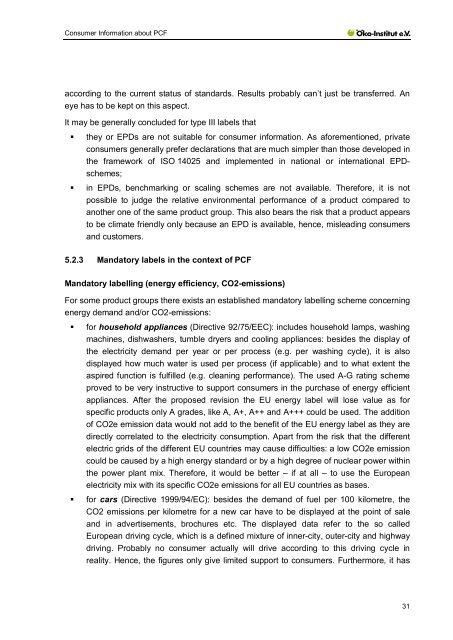Requirements on Consumer Information about Product ... - ANEC
Requirements on Consumer Information about Product ... - ANEC
Requirements on Consumer Information about Product ... - ANEC
Create successful ePaper yourself
Turn your PDF publications into a flip-book with our unique Google optimized e-Paper software.
C<strong>on</strong>sumer Informati<strong>on</strong> <strong>about</strong> PCF<br />
according to the current status of standards. Results probably can’t just be transferred. An<br />
eye has to be kept <strong>on</strong> this aspect.<br />
It may be generally c<strong>on</strong>cluded for type III labels that<br />
• they or EPDs are not suitable for c<strong>on</strong>sumer informati<strong>on</strong>. As aforementi<strong>on</strong>ed, private<br />
c<strong>on</strong>sumers generally prefer declarati<strong>on</strong>s that are much simpler than those developed in<br />
the framework of ISO 14025 and implemented in nati<strong>on</strong>al or internati<strong>on</strong>al EPDschemes;<br />
• in EPDs, benchmarking or scaling schemes are not available. Therefore, it is not<br />
possible to judge the relative envir<strong>on</strong>mental performance of a product compared to<br />
another <strong>on</strong>e of the same product group. This also bears the risk that a product appears<br />
to be climate friendly <strong>on</strong>ly because an EPD is available, hence, misleading c<strong>on</strong>sumers<br />
and customers.<br />
5.2.3 Mandatory labels in the c<strong>on</strong>text of PCF<br />
Mandatory labelling (energy efficiency, CO2-emissi<strong>on</strong>s)<br />
For some product groups there exists an established mandatory labelling scheme c<strong>on</strong>cerning<br />
energy demand and/or CO2-emissi<strong>on</strong>s:<br />
• for household appliances (Directive 92/75/EEC): includes household lamps, washing<br />
machines, dishwashers, tumble dryers and cooling appliances: besides the display of<br />
the electricity demand per year or per process (e.g. per washing cycle), it is also<br />
displayed how much water is used per process (if applicable) and to what extent the<br />
aspired functi<strong>on</strong> is fulfilled (e.g. cleaning performance). The used A-G rating scheme<br />
proved to be very instructive to support c<strong>on</strong>sumers in the purchase of energy efficient<br />
appliances. After the proposed revisi<strong>on</strong> the EU energy label will lose value as for<br />
specific products <strong>on</strong>ly A grades, like A, A+, A++ and A+++ could be used. The additi<strong>on</strong><br />
of CO2e emissi<strong>on</strong> data would not add to the benefit of the EU energy label as they are<br />
directly correlated to the electricity c<strong>on</strong>sumpti<strong>on</strong>. Apart from the risk that the different<br />
electric grids of the different EU countries may cause difficulties: a low CO2e emissi<strong>on</strong><br />
could be caused by a high energy standard or by a high degree of nuclear power within<br />
the power plant mix. Therefore, it would be better – if at all – to use the European<br />
electricity mix with its specific CO2e emissi<strong>on</strong>s for all EU countries as bases.<br />
• for cars (Directive 1999/94/EC): besides the demand of fuel per 100 kilometre, the<br />
CO2 emissi<strong>on</strong>s per kilometre for a new car have to be displayed at the point of sale<br />
and in advertisements, brochures etc. The displayed data refer to the so called<br />
European driving cycle, which is a defined mixture of inner-city, outer-city and highway<br />
driving. Probably no c<strong>on</strong>sumer actually will drive according to this driving cycle in<br />
reality. Hence, the figures <strong>on</strong>ly give limited support to c<strong>on</strong>sumers. Furthermore, it has<br />
31
















